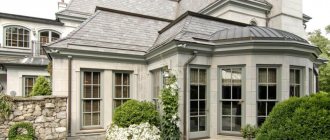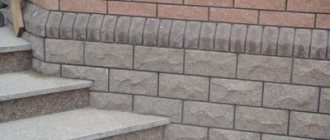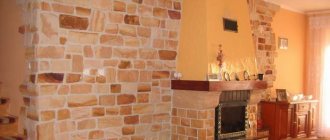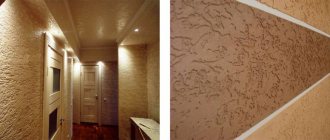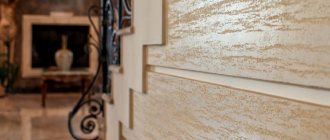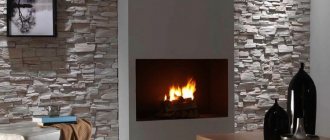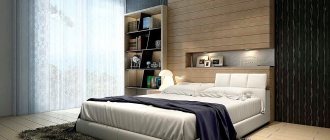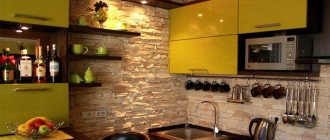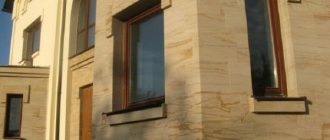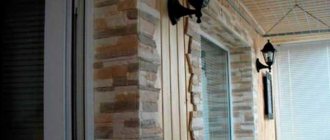It is human nature to decorate everything we can get our hands on. After all, since ancient times it has been the custom that beauty is a sign of power and greatness. Therefore, your own home was no exception. In particular, very beautiful photos of facade finishing with stone can be found on the Internet today. This is what we will talk about.
If a house is a book, then its façade is the cover of that book. And we certainly shouldn’t forget about this. Therefore, finishing the facade is an important step in home improvement. The use of natural stone is especially appreciated.
Advantages of finishing the facade with stone
Firstly, there is a huge selection of materials.
The variety of shapes and colors of panels is very important. These can be strict rectangles or completely incomprehensible shapes.
Safety. Natural material will not harm your health, and artificial stone is almost always environmentally friendly.
Reliability. Natural stone does not burn, is resistant to humidity, mechanical damage, and sudden temperature changes.
Additional sound and heat insulation.
Depending on your preferences, you can style your home as medieval, Egyptian, or northern. The possibilities are limited only by your imagination.
There is only one significant disadvantage: the rather high cost of finishing the facade.
Materials
Today on the market you can find materials that are divided into two groups:
- Artificial;
- Natural.
About artificial ones, it can be noted that they come in a variety of sizes and types. Most of them imitate natural material, and at the same time their cost is several times lower. Therefore, finishing the facade with stone panels is quite popular. But no matter how accurate the imitation is, plastic will never compare with real stone.
But you can dwell on natural materials in more detail. There are quite a few of them, but the most popular are marble, granite, limestone, labradorite, sandstone and slate.
Which one to choose for various external finishing works
When choosing a decorative stone, several parameters must be taken into account . Firstly, this is budget . Natural stone is sold at prices several times higher than the cost of artificial materials. In this case, the consumer will have to spend money not only when purchasing materials, but also during installation. To obtain high-quality results, it is recommended to contact specialists. It is quite difficult to do cladding with natural materials yourself.
Facade stone sandstone, sawn, tumbled, fired, 10x10 cm, thickness 3 cm (crimson). Photo Wild stone
Secondly, color . Natural breeds have heterogeneity in color. Stones from different batches can vary significantly in color, which significantly complicates the cladding process. All artificial stone products have the same color. There are also several recommendations for choosing natural materials:
- green and blue colors help create a business atmosphere in administrative buildings;
- “warm” shades: beige, pink, brown - create an atmosphere of comfort, so these colors are great for residential buildings and cottages;
Reference. An important argument in favor of choosing light-colored products is the fact that the products heat up less under the sun's rays.
Thirdly, it is necessary to pay special attention to the characteristics of the rock if cladding from natural elements is intended. Granite materials have the best parameters.
...for facades, walls of private houses
In principle, various types of artificial and natural stone are suitable for cladding the facades of private houses . Limestone, sandstone and shell rock are most in demand, as they have the most affordable cost among natural options. White sandstone will give the building a luxurious look. Marble cladding attracts attention and can tell a lot about the owners of the house. Granite cladding will give the building a monumental appearance. Natural cladding blends harmoniously with any natural landscape.
Decorative concrete tile RAMO Dolomite Euro dark gray. Photo by Maxidom
Artificial stone is popular among private consumers as it is a financially beneficial solution. When choosing, you need to pay attention to the characteristics of the product: uniformity of structure and color, thickness, strength and resistance to low temperatures. The stone must have uniform thickness and uniform composition (the size of the filler should not exceed 5 mm in diameter), coloring must be present throughout the entire thickness, and not just on the surface.
...for plinth and foundation
Among the artificial options, torn stone is most in demand for cladding the base part. Finishing with natural stone is the best option for the base and foundation. If affordable products are chosen , then for cladding the basement and foundation of the building it is possible to choose any option rich in price, characteristics and design , for example, granite and marble. In any case, it all depends on the financial capabilities and personal preferences of the owner.
Sandstone finishing. Photo Camelot178
...for the pond
Decorative stone is used not only for external cladding of buildings, but also for solving problems in landscape design. It is successfully used for finishing reservoirs of artificial and natural origin, located:
- in the coastal zone, large stones are used for fencing;
- in shallow water;
- at the bottom;
- to create alpine slides and waterfalls, stones can be laid in such a way as to form a kind of cascade.
Natural products are more suitable for reservoirs; their use makes it possible to create a natural-looking structure that will harmoniously combine with the surrounding landscape. In addition to standard facing stones, crumbs, crushed stone, and large boulders are used to decorate reservoirs.
Where else is it used?
Decorative stone is suitable for cladding civil, administrative, municipal, state and commercial buildings. The material is popular for finishing buildings located on private property: country and private houses, cottages, bathhouses, etc., made of stone and concrete. Popular finishing of the base and foundation of buildings made of stone, brick, concrete, wood, and frame buildings. Facades and individual parts of restaurant and cafe buildings are often decorated using decorative stone.
The plinth is faced with granite. Photo Green Time
Decorative stone is used for finishing steps, doors and windows, arched openings, house paths, fences and railings, columns and pillars, ponds and fountains, suitable for creating landscape compositions, alpine slides, dry streams, rock gardens, rockeries. Certain types are used for the construction of fences and fences, structural supports.
Granite
In terms of price and external characteristics, it is on par with marble. It comes in both glossy (polished) and matte (not polished). It looks very impressive next to nature.
Granite can be divided into three types based on color scheme:
- Plagiogranite - gray shades predominate;
- Alaskite - reddish-pink shades predominate;
- Porphyritic granite is a cross between the other two types.
Limestone
It is quite possible that this is an ideal stone for exterior facade decoration. Its main advantage is that it is easy to process. Therefore, it can have a wide variety of forms.
The surface of the material can be either polished or embossed. The color of the stone depends on its composition, most often yellow and white.
Insulators ShF-20G- Production of plastic for finishing
How and how to caulk a timber house with your own hands: materials and step-by-step instructions
By the way, this is what the Egyptians used when building the pyramids. However, this material is not suitable for every climate. The stone can easily collapse due to temperature changes, high humidity or changing seasons.
Installation
Installation of artificial stone can be done wet or dry. The first method is easier to implement; it is used for cladding high monolithic structures and involves the use of a primer and an adhesive mixture. And the sequence of work is as follows:
- preparation of the working surface, leveling;
- priming using a deep penetration agent;
- applying glue to the back of the stone and to the base;
- stone laying;
- grouting joints with a sealing solution.
Reference. If the seams are not filled, then there is a high probability that moisture will penetrate under the cladding and begin to affect the adhesive solution. As a result, the finish will begin to peel off.
The dry method is more reliable and more costly from a financial and physical point of view, and is used in the construction of low fences. The technology requires a number of activities:
- installation of heat and vapor barrier materials;
- lathing device;
- horizontal marking device;
- stone fastening;
- filling joints with dry construction mixtures.
Natural stone has significant weight, so its installation is often difficult for non-professional performers. And the installation process includes a large number of stages, not only the main ones, but also the preparatory ones. Installation includes the following steps:
1) Reinforcement of walls. The walls of a house built a long time ago need to be strengthened:
- removal of old finishing material;
- strengthening the surface by sealing cracks and cracks;
- installation of metal mesh.
To strengthen the facade, the method of preliminary plastering is most often used:
- The first layer is made of liquid cement mortar (one part cement and three parts sand, water is added to the mixture until the consistency of liquid sour cream is obtained), which is applied to the surface by spraying using a paint brush.
- Installation of metal plaster mesh is carried out using dowels. 10-16 dowels are needed per square meter. The mesh is attached with an overlap of 5-7 cm.
- The second layer is made from a solution (four parts sand and one part cement) that covers the mesh. The mixture must fill all the cells, so the layer thickness must be at least 10 mm.
- While the solution has not hardened, the surface is given a relief appearance using a notched trowel. The indentations remaining on the surface will ensure reliable adhesion between the stone and the wall.
Reference. The wall is reinforced for laying artificial stone in a similar way.
2) Preparation of facing material.
- Natural stones do not have the correct shape, so adjustment and modification of the products will be required. To do this, the stones are laid out on a polyethylene sheet on a flat surface in the same way as they will be located on the facade. The distance between stones must be at least 8 mm.
Attention. For ease of installation, the stones can be numbered.
Reference. The lower and upper rows must be formed from stones of the same size, which ensures harmony of the cladding.
- Refinement of stones. For cladding you will need corner products that need to be made. To do this you will need a grinder with a diamond blade. A cut in the shape of a right angle is formed in a stone of suitable thickness. Protrusions and excess fragments are removed with a hammer and chisel.
3) Laying stones. Fixation is carried out using cement-based adhesive mixtures: Ceresit CM 17, WEISBAU strong, Litokol LITOFLEX K80. Priming with special solutions helps improve adhesion. It is necessary to use primers for external work. Laying is done as follows:
- the back side of the stones is moistened, it is necessary to allow the liquid to be absorbed, wait 30-60 seconds;
- the adhesive mixture is applied in an even layer no more than 1.5 cm thick on the back side of the stones;
- using a spatula or trowel, grooves are formed in the solution;
- the stone is pressed against the wall and held for several seconds;
- other stones are laid in the same way, between which gaps of the selected width are left.
4) Grouting of joints is done with an adhesive mixture or special grouts, which are placed in special cone-shaped bags with a hole at the end. The grout hardens within 50-60 minutes.
Sandstone
Svidu is very similar to limestone, but stronger and more reliable. Compared to other types of materials, it is lighter, which makes it possible to use it in interior decoration.
You can find several types of sandstone on the market today:
- Oolitic;
- Pisolite;
- Shell rock;
- Lithographic.
However, only oolitic and pisolite are suitable for our work. The other two are used in the construction of foundations and walls of buildings.
Types of masonry
Decorating a house with stone can have different masonry:
- A die is a flat, rolled piece of rock. It is important to select the elements correctly, leaving a minimum distance between them.
- The castle resembles a medieval castle.
- The plateau involves sawing the slabs into rectangular elements with sides of 5 cm. The corners around the perimeter are chipped.
- Shahriar - the tiles are sawn into elements with dimensions of 25x6 cm. The corners are cut off.
- Assol - harmonious laying out of dies with their ends.
- Rondo - large stones are laid, gaps are filled with small specimens.
Natural and decorative facade stone is used for cladding buildings. The house takes on a rich appearance and durability.
